Ethical and Governance Report: Health Warnings on BBT Cigarettes
VerifiedAdded on 2020/07/23
|7
|1578
|42
Report
AI Summary
This report delves into the ethical and governance issues surrounding the implementation of health warnings on BBT cigarette packets in China. It explores the perspectives of internal and external stakeholders, analyzing how the decision to include health warnings impacts their interests. The report examines the ethical issues, referencing relevant regulations and the WHO's Framework Convention on Tobacco Control. It also assesses the role of PR, specifically Randall Hedges, in navigating corporate responsibility and influencing the decision-making process. The conclusion emphasizes the importance of corporate social responsibility and the need for cigarette companies to collaborate with the Chinese government to raise awareness about the dangers of smoking.
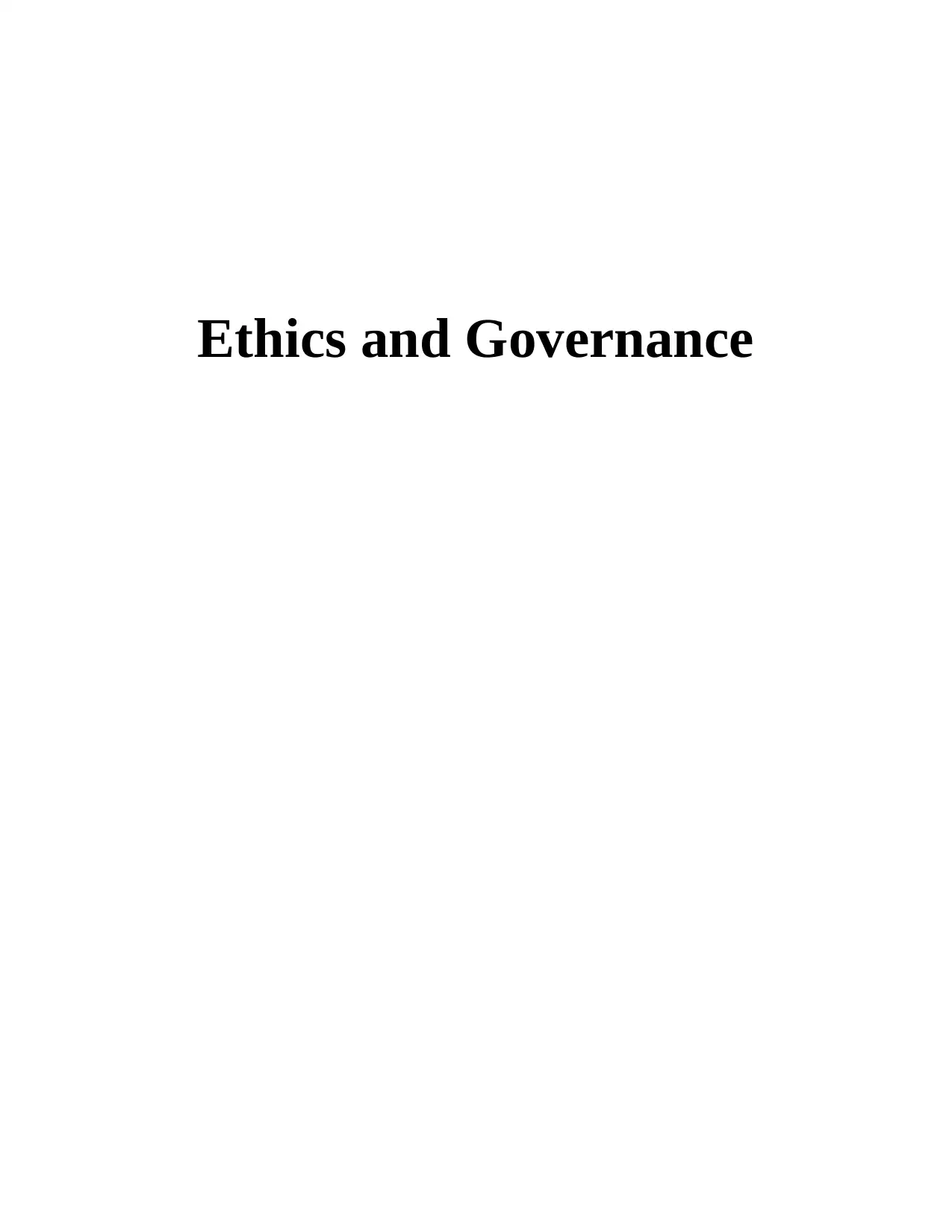
Ethics and Governance
Paraphrase This Document
Need a fresh take? Get an instant paraphrase of this document with our AI Paraphraser
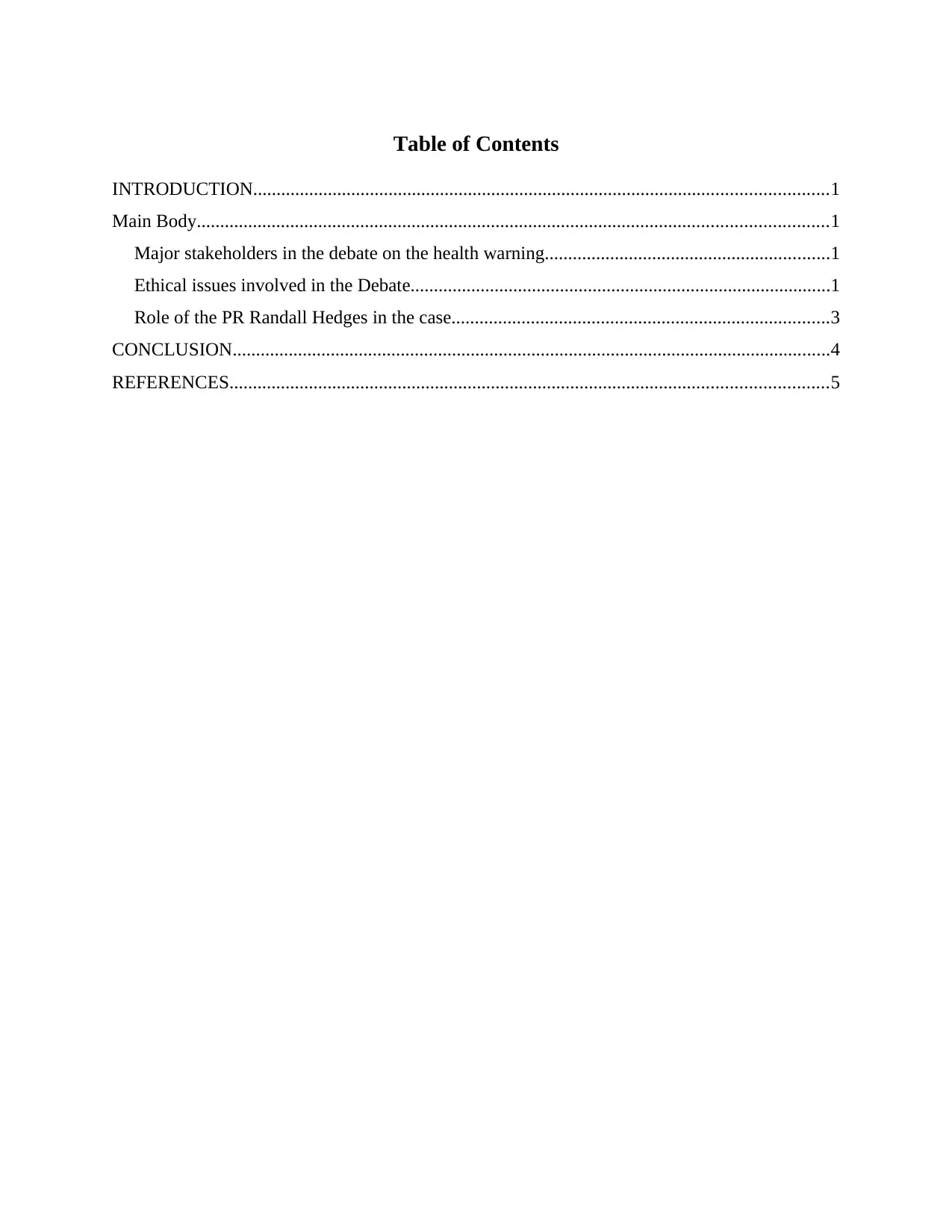
Table of Contents
INTRODUCTION...........................................................................................................................1
Main Body.......................................................................................................................................1
Major stakeholders in the debate on the health warning.............................................................1
Ethical issues involved in the Debate..........................................................................................1
Role of the PR Randall Hedges in the case.................................................................................3
CONCLUSION................................................................................................................................4
REFERENCES................................................................................................................................5
INTRODUCTION...........................................................................................................................1
Main Body.......................................................................................................................................1
Major stakeholders in the debate on the health warning.............................................................1
Ethical issues involved in the Debate..........................................................................................1
Role of the PR Randall Hedges in the case.................................................................................3
CONCLUSION................................................................................................................................4
REFERENCES................................................................................................................................5
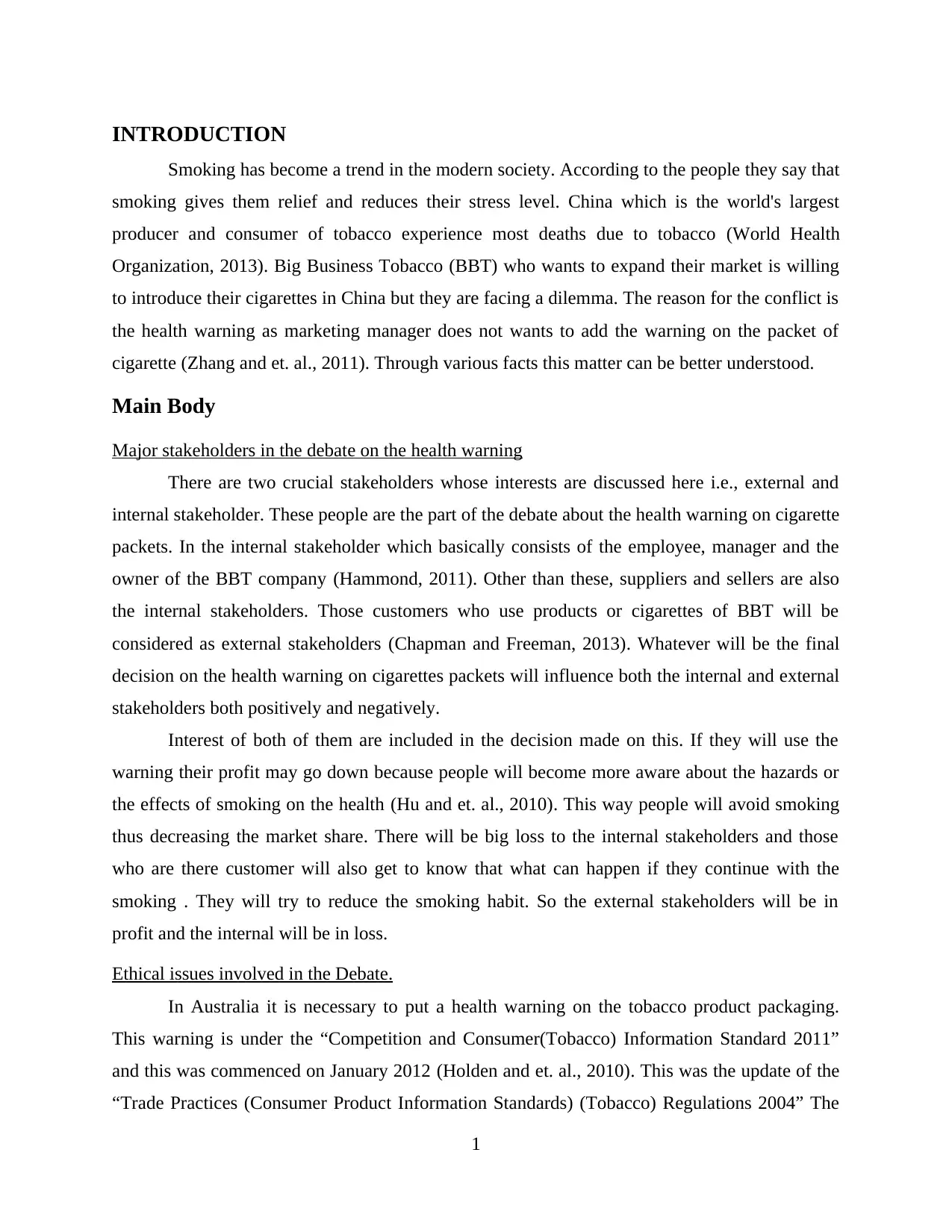
INTRODUCTION
Smoking has become a trend in the modern society. According to the people they say that
smoking gives them relief and reduces their stress level. China which is the world's largest
producer and consumer of tobacco experience most deaths due to tobacco (World Health
Organization, 2013). Big Business Tobacco (BBT) who wants to expand their market is willing
to introduce their cigarettes in China but they are facing a dilemma. The reason for the conflict is
the health warning as marketing manager does not wants to add the warning on the packet of
cigarette (Zhang and et. al., 2011). Through various facts this matter can be better understood.
Main Body
Major stakeholders in the debate on the health warning
There are two crucial stakeholders whose interests are discussed here i.e., external and
internal stakeholder. These people are the part of the debate about the health warning on cigarette
packets. In the internal stakeholder which basically consists of the employee, manager and the
owner of the BBT company (Hammond, 2011). Other than these, suppliers and sellers are also
the internal stakeholders. Those customers who use products or cigarettes of BBT will be
considered as external stakeholders (Chapman and Freeman, 2013). Whatever will be the final
decision on the health warning on cigarettes packets will influence both the internal and external
stakeholders both positively and negatively.
Interest of both of them are included in the decision made on this. If they will use the
warning their profit may go down because people will become more aware about the hazards or
the effects of smoking on the health (Hu and et. al., 2010). This way people will avoid smoking
thus decreasing the market share. There will be big loss to the internal stakeholders and those
who are there customer will also get to know that what can happen if they continue with the
smoking . They will try to reduce the smoking habit. So the external stakeholders will be in
profit and the internal will be in loss.
Ethical issues involved in the Debate.
In Australia it is necessary to put a health warning on the tobacco product packaging.
This warning is under the “Competition and Consumer(Tobacco) Information Standard 2011”
and this was commenced on January 2012 (Holden and et. al., 2010). This was the update of the
“Trade Practices (Consumer Product Information Standards) (Tobacco) Regulations 2004” The
1
Smoking has become a trend in the modern society. According to the people they say that
smoking gives them relief and reduces their stress level. China which is the world's largest
producer and consumer of tobacco experience most deaths due to tobacco (World Health
Organization, 2013). Big Business Tobacco (BBT) who wants to expand their market is willing
to introduce their cigarettes in China but they are facing a dilemma. The reason for the conflict is
the health warning as marketing manager does not wants to add the warning on the packet of
cigarette (Zhang and et. al., 2011). Through various facts this matter can be better understood.
Main Body
Major stakeholders in the debate on the health warning
There are two crucial stakeholders whose interests are discussed here i.e., external and
internal stakeholder. These people are the part of the debate about the health warning on cigarette
packets. In the internal stakeholder which basically consists of the employee, manager and the
owner of the BBT company (Hammond, 2011). Other than these, suppliers and sellers are also
the internal stakeholders. Those customers who use products or cigarettes of BBT will be
considered as external stakeholders (Chapman and Freeman, 2013). Whatever will be the final
decision on the health warning on cigarettes packets will influence both the internal and external
stakeholders both positively and negatively.
Interest of both of them are included in the decision made on this. If they will use the
warning their profit may go down because people will become more aware about the hazards or
the effects of smoking on the health (Hu and et. al., 2010). This way people will avoid smoking
thus decreasing the market share. There will be big loss to the internal stakeholders and those
who are there customer will also get to know that what can happen if they continue with the
smoking . They will try to reduce the smoking habit. So the external stakeholders will be in
profit and the internal will be in loss.
Ethical issues involved in the Debate.
In Australia it is necessary to put a health warning on the tobacco product packaging.
This warning is under the “Competition and Consumer(Tobacco) Information Standard 2011”
and this was commenced on January 2012 (Holden and et. al., 2010). This was the update of the
“Trade Practices (Consumer Product Information Standards) (Tobacco) Regulations 2004” The
1
⊘ This is a preview!⊘
Do you want full access?
Subscribe today to unlock all pages.

Trusted by 1+ million students worldwide
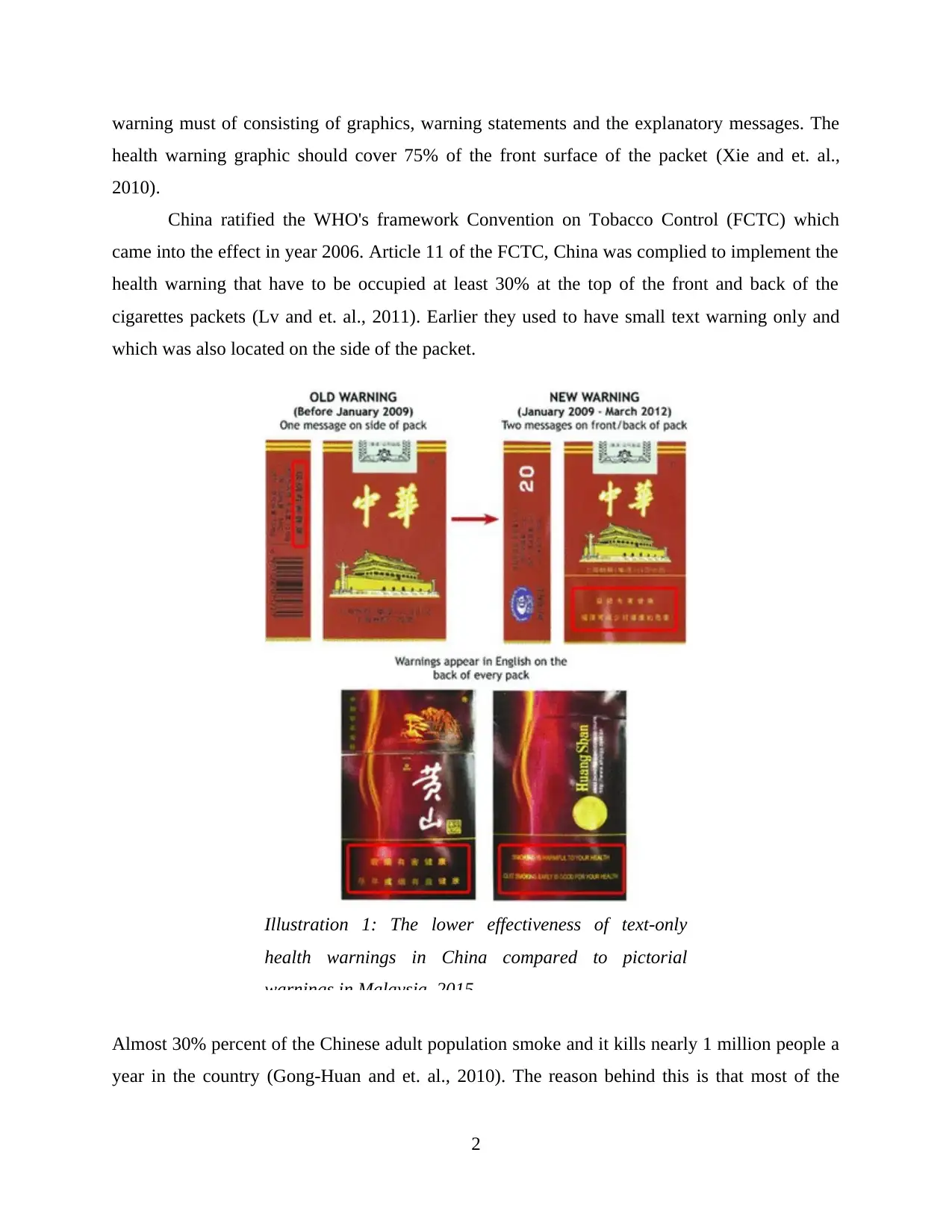
warning must of consisting of graphics, warning statements and the explanatory messages. The
health warning graphic should cover 75% of the front surface of the packet (Xie and et. al.,
2010).
China ratified the WHO's framework Convention on Tobacco Control (FCTC) which
came into the effect in year 2006. Article 11 of the FCTC, China was complied to implement the
health warning that have to be occupied at least 30% at the top of the front and back of the
cigarettes packets (Lv and et. al., 2011). Earlier they used to have small text warning only and
which was also located on the side of the packet.
Almost 30% percent of the Chinese adult population smoke and it kills nearly 1 million people a
year in the country (Gong-Huan and et. al., 2010). The reason behind this is that most of the
2
Illustration 1: The lower effectiveness of text-only
health warnings in China compared to pictorial
warnings in Malaysia, 2015
health warning graphic should cover 75% of the front surface of the packet (Xie and et. al.,
2010).
China ratified the WHO's framework Convention on Tobacco Control (FCTC) which
came into the effect in year 2006. Article 11 of the FCTC, China was complied to implement the
health warning that have to be occupied at least 30% at the top of the front and back of the
cigarettes packets (Lv and et. al., 2011). Earlier they used to have small text warning only and
which was also located on the side of the packet.
Almost 30% percent of the Chinese adult population smoke and it kills nearly 1 million people a
year in the country (Gong-Huan and et. al., 2010). The reason behind this is that most of the
2
Illustration 1: The lower effectiveness of text-only
health warnings in China compared to pictorial
warnings in Malaysia, 2015
Paraphrase This Document
Need a fresh take? Get an instant paraphrase of this document with our AI Paraphraser
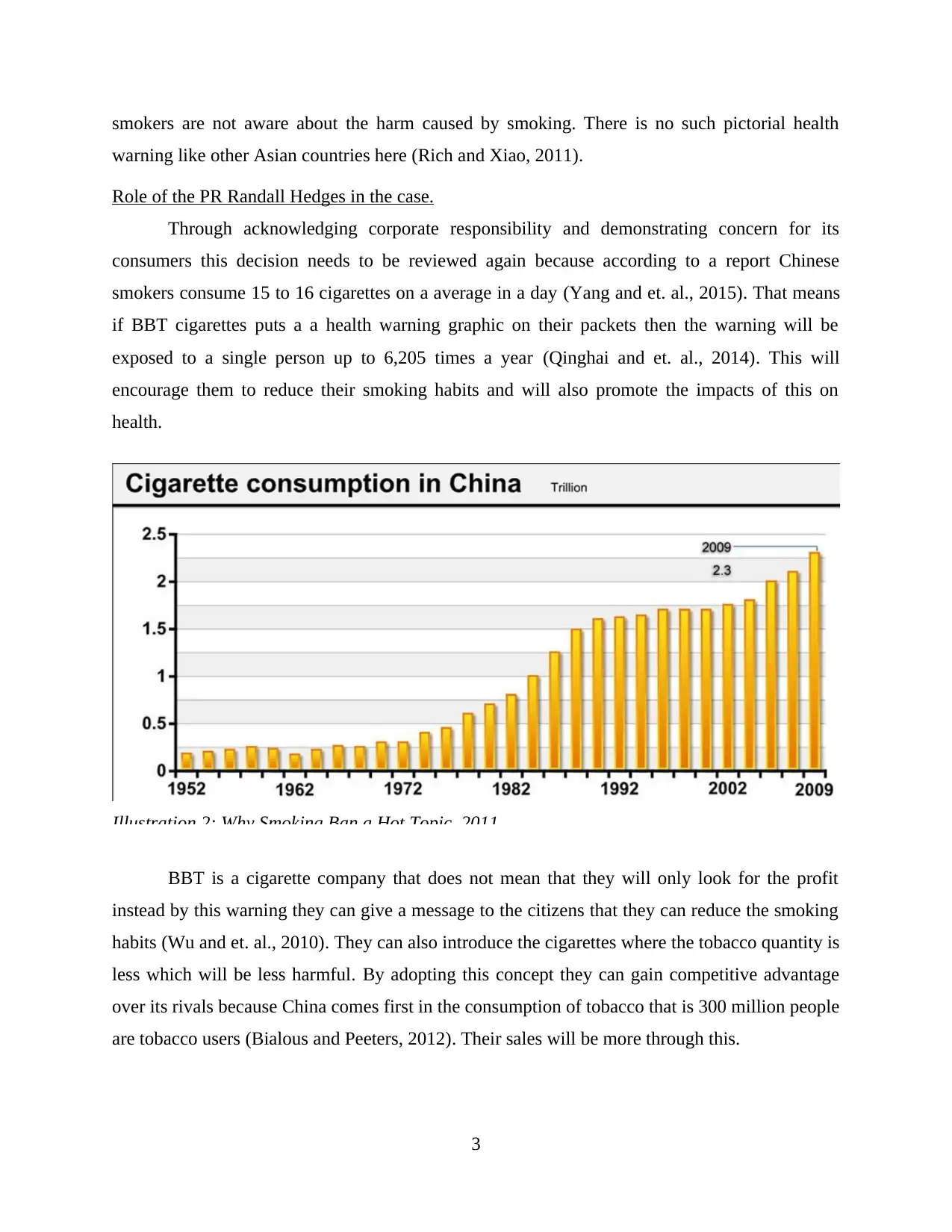
smokers are not aware about the harm caused by smoking. There is no such pictorial health
warning like other Asian countries here (Rich and Xiao, 2011).
Role of the PR Randall Hedges in the case.
Through acknowledging corporate responsibility and demonstrating concern for its
consumers this decision needs to be reviewed again because according to a report Chinese
smokers consume 15 to 16 cigarettes on a average in a day (Yang and et. al., 2015). That means
if BBT cigarettes puts a a health warning graphic on their packets then the warning will be
exposed to a single person up to 6,205 times a year (Qinghai and et. al., 2014). This will
encourage them to reduce their smoking habits and will also promote the impacts of this on
health.
BBT is a cigarette company that does not mean that they will only look for the profit
instead by this warning they can give a message to the citizens that they can reduce the smoking
habits (Wu and et. al., 2010). They can also introduce the cigarettes where the tobacco quantity is
less which will be less harmful. By adopting this concept they can gain competitive advantage
over its rivals because China comes first in the consumption of tobacco that is 300 million people
are tobacco users (Bialous and Peeters, 2012). Their sales will be more through this.
3
Illustration 2: Why Smoking Ban a Hot Topic, 2011
warning like other Asian countries here (Rich and Xiao, 2011).
Role of the PR Randall Hedges in the case.
Through acknowledging corporate responsibility and demonstrating concern for its
consumers this decision needs to be reviewed again because according to a report Chinese
smokers consume 15 to 16 cigarettes on a average in a day (Yang and et. al., 2015). That means
if BBT cigarettes puts a a health warning graphic on their packets then the warning will be
exposed to a single person up to 6,205 times a year (Qinghai and et. al., 2014). This will
encourage them to reduce their smoking habits and will also promote the impacts of this on
health.
BBT is a cigarette company that does not mean that they will only look for the profit
instead by this warning they can give a message to the citizens that they can reduce the smoking
habits (Wu and et. al., 2010). They can also introduce the cigarettes where the tobacco quantity is
less which will be less harmful. By adopting this concept they can gain competitive advantage
over its rivals because China comes first in the consumption of tobacco that is 300 million people
are tobacco users (Bialous and Peeters, 2012). Their sales will be more through this.
3
Illustration 2: Why Smoking Ban a Hot Topic, 2011
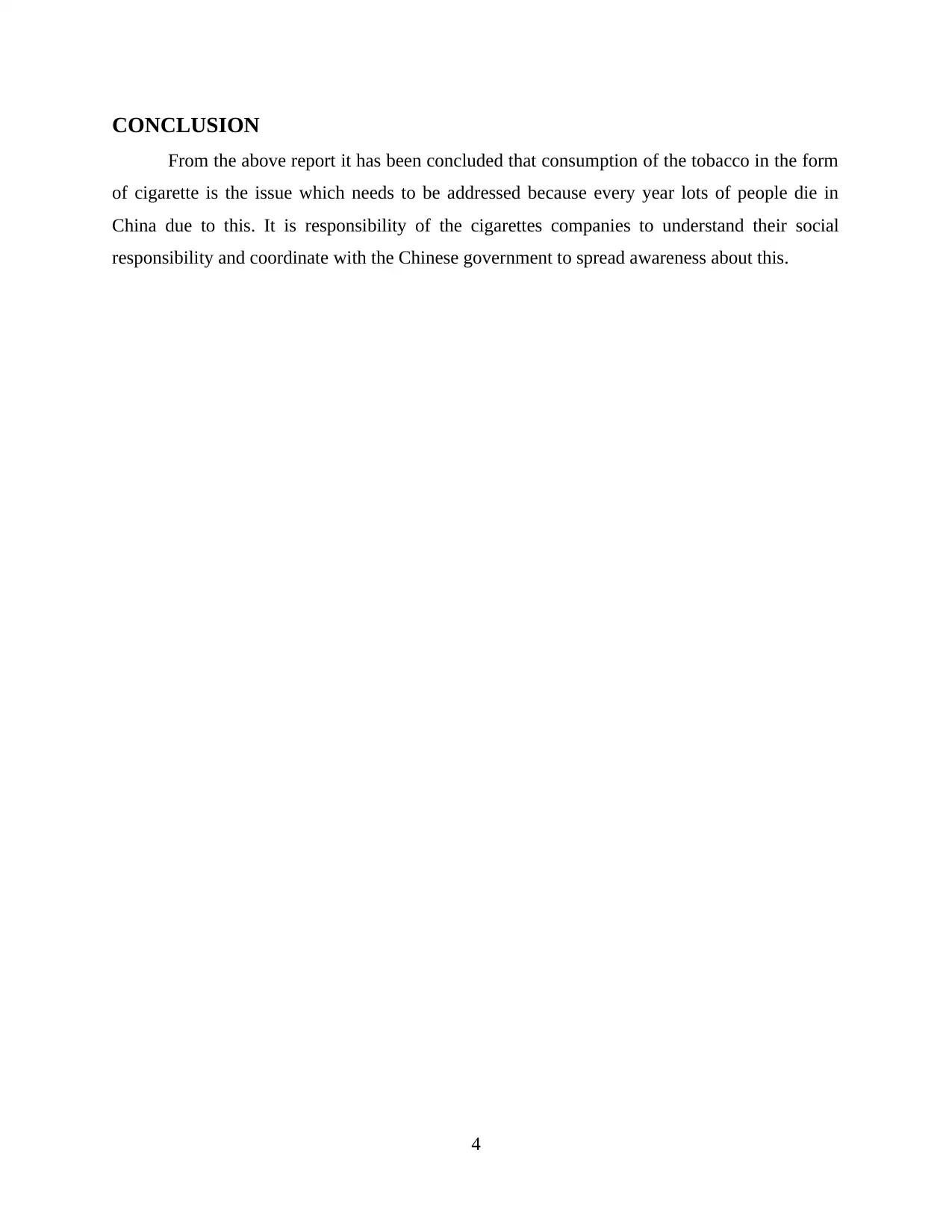
CONCLUSION
From the above report it has been concluded that consumption of the tobacco in the form
of cigarette is the issue which needs to be addressed because every year lots of people die in
China due to this. It is responsibility of the cigarettes companies to understand their social
responsibility and coordinate with the Chinese government to spread awareness about this.
4
From the above report it has been concluded that consumption of the tobacco in the form
of cigarette is the issue which needs to be addressed because every year lots of people die in
China due to this. It is responsibility of the cigarettes companies to understand their social
responsibility and coordinate with the Chinese government to spread awareness about this.
4
⊘ This is a preview!⊘
Do you want full access?
Subscribe today to unlock all pages.

Trusted by 1+ million students worldwide
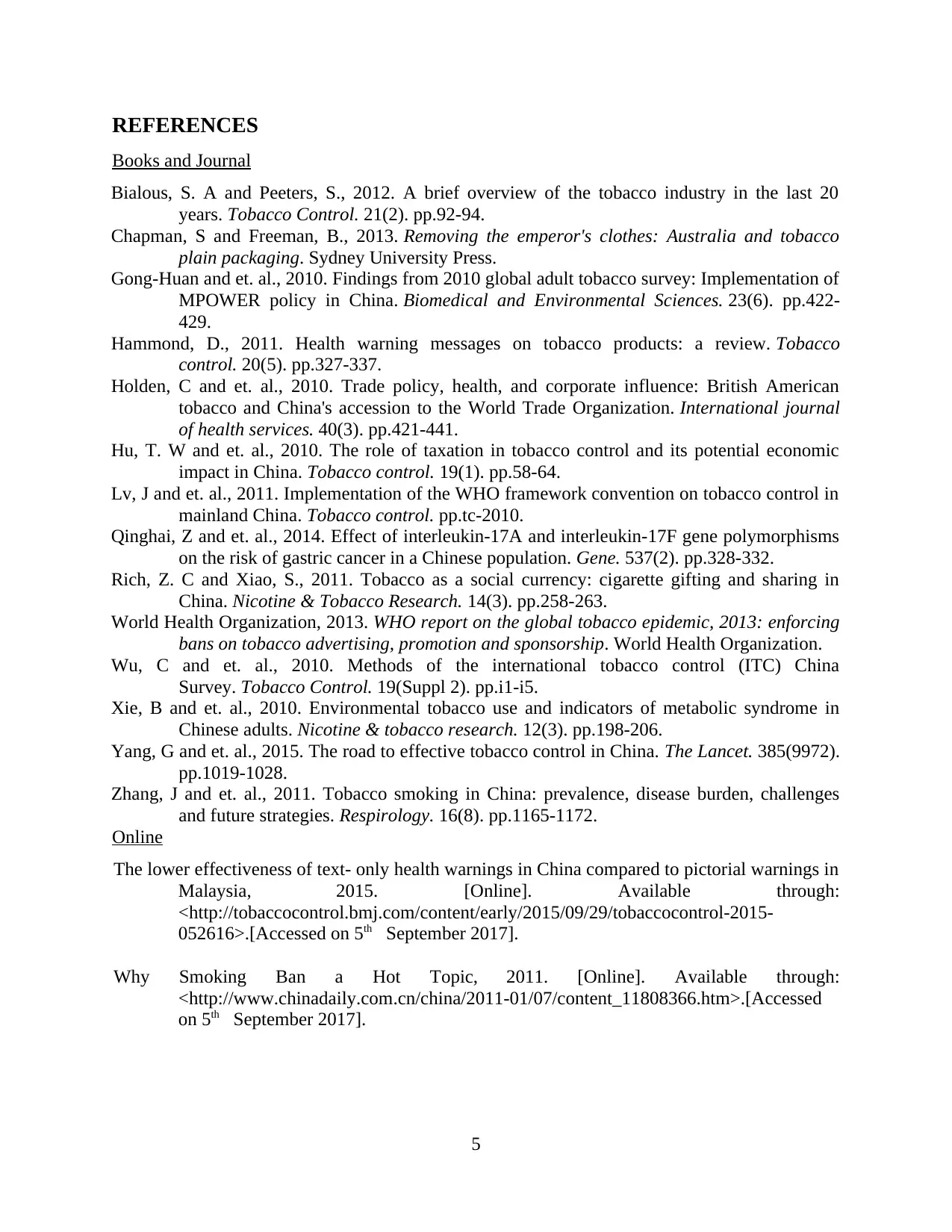
REFERENCES
Books and Journal
Bialous, S. A and Peeters, S., 2012. A brief overview of the tobacco industry in the last 20
years. Tobacco Control. 21(2). pp.92-94.
Chapman, S and Freeman, B., 2013. Removing the emperor's clothes: Australia and tobacco
plain packaging. Sydney University Press.
Gong-Huan and et. al., 2010. Findings from 2010 global adult tobacco survey: Implementation of
MPOWER policy in China. Biomedical and Environmental Sciences. 23(6). pp.422-
429.
Hammond, D., 2011. Health warning messages on tobacco products: a review. Tobacco
control. 20(5). pp.327-337.
Holden, C and et. al., 2010. Trade policy, health, and corporate influence: British American
tobacco and China's accession to the World Trade Organization. International journal
of health services. 40(3). pp.421-441.
Hu, T. W and et. al., 2010. The role of taxation in tobacco control and its potential economic
impact in China. Tobacco control. 19(1). pp.58-64.
Lv, J and et. al., 2011. Implementation of the WHO framework convention on tobacco control in
mainland China. Tobacco control. pp.tc-2010.
Qinghai, Z and et. al., 2014. Effect of interleukin-17A and interleukin-17F gene polymorphisms
on the risk of gastric cancer in a Chinese population. Gene. 537(2). pp.328-332.
Rich, Z. C and Xiao, S., 2011. Tobacco as a social currency: cigarette gifting and sharing in
China. Nicotine & Tobacco Research. 14(3). pp.258-263.
World Health Organization, 2013. WHO report on the global tobacco epidemic, 2013: enforcing
bans on tobacco advertising, promotion and sponsorship. World Health Organization.
Wu, C and et. al., 2010. Methods of the international tobacco control (ITC) China
Survey. Tobacco Control. 19(Suppl 2). pp.i1-i5.
Xie, B and et. al., 2010. Environmental tobacco use and indicators of metabolic syndrome in
Chinese adults. Nicotine & tobacco research. 12(3). pp.198-206.
Yang, G and et. al., 2015. The road to effective tobacco control in China. The Lancet. 385(9972).
pp.1019-1028.
Zhang, J and et. al., 2011. Tobacco smoking in China: prevalence, disease burden, challenges
and future strategies. Respirology. 16(8). pp.1165-1172.
Online
The lower effectiveness of text- only health warnings in China compared to pictorial warnings in
Malaysia, 2015. [Online]. Available through:
<http://tobaccocontrol.bmj.com/content/early/2015/09/29/tobaccocontrol-2015-
052616>.[Accessed on 5th September 2017].
Why Smoking Ban a Hot Topic, 2011. [Online]. Available through:
<http://www.chinadaily.com.cn/china/2011-01/07/content_11808366.htm>.[Accessed
on 5th September 2017].
5
Books and Journal
Bialous, S. A and Peeters, S., 2012. A brief overview of the tobacco industry in the last 20
years. Tobacco Control. 21(2). pp.92-94.
Chapman, S and Freeman, B., 2013. Removing the emperor's clothes: Australia and tobacco
plain packaging. Sydney University Press.
Gong-Huan and et. al., 2010. Findings from 2010 global adult tobacco survey: Implementation of
MPOWER policy in China. Biomedical and Environmental Sciences. 23(6). pp.422-
429.
Hammond, D., 2011. Health warning messages on tobacco products: a review. Tobacco
control. 20(5). pp.327-337.
Holden, C and et. al., 2010. Trade policy, health, and corporate influence: British American
tobacco and China's accession to the World Trade Organization. International journal
of health services. 40(3). pp.421-441.
Hu, T. W and et. al., 2010. The role of taxation in tobacco control and its potential economic
impact in China. Tobacco control. 19(1). pp.58-64.
Lv, J and et. al., 2011. Implementation of the WHO framework convention on tobacco control in
mainland China. Tobacco control. pp.tc-2010.
Qinghai, Z and et. al., 2014. Effect of interleukin-17A and interleukin-17F gene polymorphisms
on the risk of gastric cancer in a Chinese population. Gene. 537(2). pp.328-332.
Rich, Z. C and Xiao, S., 2011. Tobacco as a social currency: cigarette gifting and sharing in
China. Nicotine & Tobacco Research. 14(3). pp.258-263.
World Health Organization, 2013. WHO report on the global tobacco epidemic, 2013: enforcing
bans on tobacco advertising, promotion and sponsorship. World Health Organization.
Wu, C and et. al., 2010. Methods of the international tobacco control (ITC) China
Survey. Tobacco Control. 19(Suppl 2). pp.i1-i5.
Xie, B and et. al., 2010. Environmental tobacco use and indicators of metabolic syndrome in
Chinese adults. Nicotine & tobacco research. 12(3). pp.198-206.
Yang, G and et. al., 2015. The road to effective tobacco control in China. The Lancet. 385(9972).
pp.1019-1028.
Zhang, J and et. al., 2011. Tobacco smoking in China: prevalence, disease burden, challenges
and future strategies. Respirology. 16(8). pp.1165-1172.
Online
The lower effectiveness of text- only health warnings in China compared to pictorial warnings in
Malaysia, 2015. [Online]. Available through:
<http://tobaccocontrol.bmj.com/content/early/2015/09/29/tobaccocontrol-2015-
052616>.[Accessed on 5th September 2017].
Why Smoking Ban a Hot Topic, 2011. [Online]. Available through:
<http://www.chinadaily.com.cn/china/2011-01/07/content_11808366.htm>.[Accessed
on 5th September 2017].
5
1 out of 7
Related Documents
Your All-in-One AI-Powered Toolkit for Academic Success.
+13062052269
info@desklib.com
Available 24*7 on WhatsApp / Email
![[object Object]](/_next/static/media/star-bottom.7253800d.svg)
Unlock your academic potential
Copyright © 2020–2025 A2Z Services. All Rights Reserved. Developed and managed by ZUCOL.





